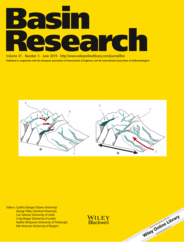
Full text loading...
 , Guillaume Dupont‐Nivet1,2,3, Jean‐Noël Proust2, Pierrick Roperch2, Laurie Bougeois4, Niels Meijer1, Joost Frieling5, Chiara Fioroni6, Sevinç Özkan Altıner7, Ezgi Vardar7, Natasha Barbolini8, Marius Stoica9, Jovid Aminov1,10, Mehmut Mamtimin3, Guo Zhaojie3
, Guillaume Dupont‐Nivet1,2,3, Jean‐Noël Proust2, Pierrick Roperch2, Laurie Bougeois4, Niels Meijer1, Joost Frieling5, Chiara Fioroni6, Sevinç Özkan Altıner7, Ezgi Vardar7, Natasha Barbolini8, Marius Stoica9, Jovid Aminov1,10, Mehmut Mamtimin3, Guo Zhaojie3
The proto‐Paratethys Sea covered a vast area extending from the Mediterranean Tethys to the Tarim Basin in western China during Cretaceous and early Paleogene. Climate modelling and proxy studies suggest that Asian aridification has been governed by westerly moisture modulated by fluctuations of the proto‐Paratethys Sea. Transgressive and regressive episodes of the proto‐Paratethys Sea have been previously recognized but their timing, extent and depositional environments remain poorly constrained. This hampers understanding of their driving mechanisms (tectonic and/or eustatic) and their contribution to Asian aridification. Here, we present a new chronostratigraphic framework based on biostratigraphy and magnetostratigraphy as well as a detailed palaeoenvironmental analysis for the Paleogene proto‐Paratethys Sea incursions in the Tajik and Tarim basins. This enables us to identify the major drivers of marine fluctuations and their potential consequences on Asian aridification. A major regional restriction event, marked by the exceptionally thick (≤ 400 m) shelf evaporites is assigned a Danian‐Selandian age (ca. 63–59 Ma) in the Aertashi Formation. This is followed by the largest recorded proto‐Paratethys Sea incursion with a transgression estimated as early Thanetian (ca. 59–57 Ma) and a regression within the Ypresian (ca. 53–52 Ma), both within the Qimugen Formation. The transgression of the next incursion in the Kalatar and Wulagen formations is now constrained as early Lutetian (ca. 47–46 Ma), whereas its regression in the Bashibulake Formation is constrained as late Lutetian (ca. 41 Ma) and is associated with a drastic increase in both tectonic subsidence and basin infilling. The age of the final and least pronounced sea incursion restricted to the westernmost margin of the Tarim Basin is assigned as Bartonian–Priabonian (ca. 39.7–36.7 Ma). We interpret the long‐term westward retreat of the proto‐Paratethys Sea starting at ca. 41 Ma to be associated with far‐field tectonic effects of the Indo‐Asia collision and Pamir/Tibetan plateau uplift. Short‐term eustatic sea level transgressions are superimposed on this long‐term regression and seem coeval with the transgression events in the other northern Peri‐Tethyan sedimentary provinces for the 1st and 2nd sea incursions. However, the 3rd sea incursion is interpreted as related to tectonism. The transgressive and regressive intervals of the proto‐Paratethys Sea correlate well with the reported humid and arid phases, respectively in the Qaidam and Xining basins, thus demonstrating the role of the proto‐Paratethys Sea as an important moisture source for the Asian interior and its regression as a contributor to Asian aridification.

Article metrics loading...

Full text loading...
References


Data & Media loading...

